
Book Covers, page 2
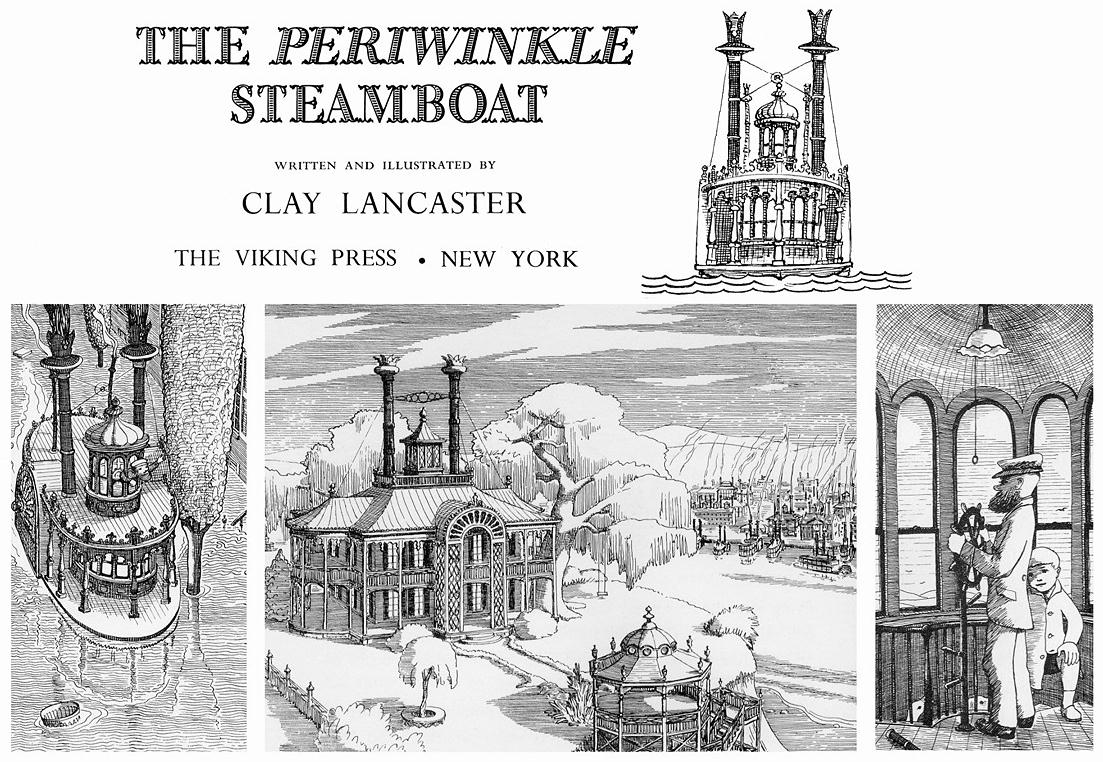
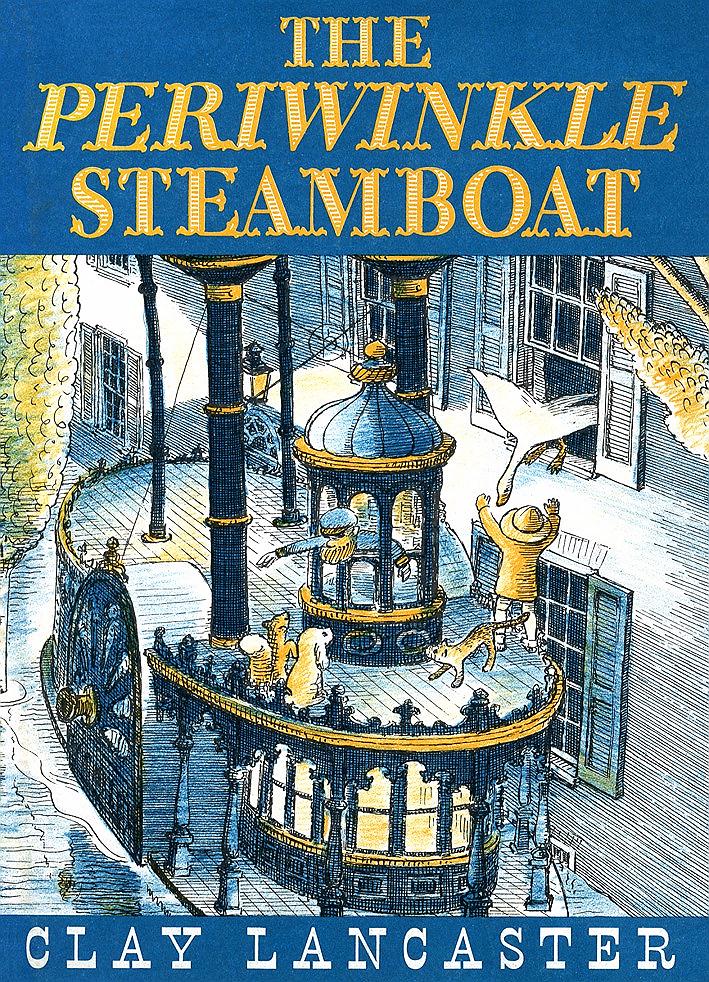
In 1987 Clay Lancaster reissued this book in a horizontal format under the title of THE FLIGHT OF THE PERIWINKLE. The summary below incorporates ingredients from the 1961 and 1987 editions.
Baseport seems to have have been a reincarnation of New Orleans in this parallel universe where the equestrian statue reminiscent of Andrew Jackson becomes the equestrian statue of "General Stonewall" who had saved Baseport "from Pirates" rather than the British.
South of Baseport where the river flows into the Gulf stood the Southern mansion called Steamboat Bluff which has two steamboat style smokestacks protruding from the roof.
Clay Lancaster's storytelling accompanied by his imaginative drawings of architecture implies that the whole tale was spun from a dream Timmy had in his sleep.
THE PERIWINKLE STEAMBOAT
Written and Illustrated by Clay Lancaster
Published by Viking - March 20th, 1961
Through the upstairs upstairs window of Timmy's bedroom during that cold rainy night on Pennypacker Square came three talking animals who joined Timmy and his puppy Dingle: a goose who got lost from its flock, a squirrel that the wind blew out of his tree, and a cat who got wet in the rain and requested that it be permitted to dry off in front of the fireplace.
Timmy heard a steam whistle in the street and looking down he saw the street was flooded and a little sidewheel steamboat named the PERIWINKLE commanded by Captain Jonathan Bill was pulling up to the curb.
After Timmy gave the Captain directions he inquired if the boat had room for passengers and the Captain cordially invited Timmy, his dog, the goose, the squirrel and the cat to come aboard and join him on the voyage to Baseport.
A balloon popped out of the "bonnet" of the pilot house, expanded and pushed the stacks to the left and right and a net held the balloon in place between the stacks.
"This is a story about a flying steamboat that takes Timmy and his friends to where they want to go, and deposits Timmy and Dingle home again on the return flight.
The friends include
Blanche the goose,
Nutsy the squirrel,
and Tabby the cat;
and their host and pilot is Captain Jonathan Bill.
Through his remarkable conveyance they meet
Uncle Henry, Aunt Azalea and Nina at the Cottage in the Sycamore;
the Potentate of Poonly Poo and his courtiers Rajah and Punkah at Pachyderm Palace;
Mona Moss at Creech Castle;
Colonel Fleuroy and Miss Cynthia Louisa at Plentius Plantation;
and Captain Bill's housekeeper, Matilda, at Steamboat Bluff.
First stop on the journey was the glorious treehouse of Uncle Henry and Aunt Azalea, then on to the elephant-shaped palace of the Potentate of Poonlay Poo, and from there to blossom-shaped Sunflower Lodge. The precarious tour through the eerie domain of Mona Moss is happily offset by the hospitality extended in Plentius Plantation."
wikipedia
excerpts from the Wikipedia article on Lancaster:
Clay Lancaster (30 March 1917 - 25 December 2000), was an authority on American architecture, an orientalist, and an influential advocate of historical preservation. Among Lancaster's many non-fiction books on architectural and art history are Architectural Follies in America (1960), Ante Bellum Houses of the Bluegrass (1961), Antebellum Architecture of Kentucky (1991), The Arts and Crafts of the Animals (1993), and Pleasant Hill: Shaker Canaan in Kentucky (2000).
Lancaster was born in Lexington, Kentucky, and studied at the University of Kentucky. He spent half of 1936 at the Art Students League of New York. Returning to Lexington, he served as stage designer for the university's Guignol Theatre and was also elected to Phi Beta Kappa. He took his A.B. in Art in 1938.
In 1943, Lancaster moved to New York and, as a graduate student there, worked in Columbia University's Avery Architectural and Fine Arts Library with Talbot Hamlin, biographer of Benjamin Henry Latrobe.
At Columbia, Lancaster received the appointment of Ware Librarian. In the fifties he lectured at Cooper Union, Columbia, and the Traphagen art school in New York. In 1968 he originated a course, "Asian Art and its Influence on Europe and America," that was given at New York University.
In 1954 and 1955, during the first of two John Simon Guggenheim Fellowships, he carried out the research that underlay The Japanese Influence in America (1963); a second Guggenheim, in 1963 and 1964, supported research on the architecture of Kentucky. In 1966, Parks Commissioner Thomas Hoving appointed Lancaster curator of Brooklyn's Prospect Park, Frederick Law Olmsted's landscape masterpiece, an assignment which led to his preparation of The Prospect Park Handbook (1967).
In 1971, Clay Lancaster moved from Brooklyn to Nantucket. Here he restored an 1829 saltbox dwelling and wrote studies of historic Nantucket, of Victorian architecture, and of train terminals and stations.
Lancaster returned to live in Kentucky in 1978, purchasing Warwick, a Federal-era residence on the Kentucky River.
On the grounds of Warwick, Lancaster built several architectural follies of his own design—an eighteenth-century tea pavilion, a guest-house replicating the first-century A.D. Tower of the Winds, and an Arts and Crafts style art gallery. He also assembled an extensive acreage nearby to serve as a nature preserve, called Shantalaya ("abode of peace").
Also, in his final years, Lancaster established a charitable organization, The Warwick Foundation, to promote and extend his many interests.
The foundation sponsors tours, lectures, scholarships, exhibitions, conferences, and maintains the Warwick compound as a museum.
Lancaster died on Christmas Day in 2000. The following spring, his ashes were scattered in the ravine next to his Warwick residence.
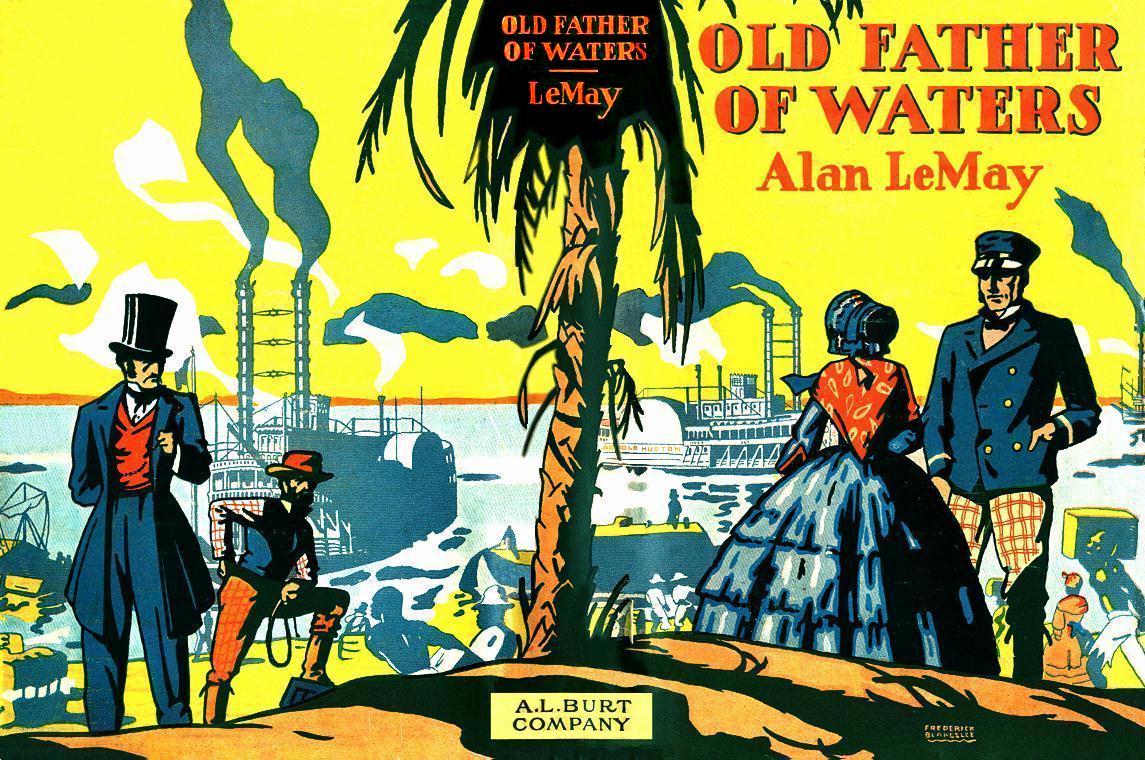
Just arrived today: a novel copyrighted 1927 & '28 by Doubleday (it may have been serialized in a magazine) in '27 and printed as book in '28) about steamboating in the 1850's. The dust jacket is a bit worn so I restored it a bit in the attached file. I already had an undated reprint of this novel which with the strange title 'RIVERMEN DIE BROKE' which led me to search online for the hardcover edition of the original publication. The artist Frederick Blakeslee (1898 - 1973) who designed the dust jacket in the style of a poster but his specialty was more realistic illustrations of "Flying Aces" in World War I "dog fights" (aerial combat).
Old Father of Waters
A Vivid Novel of the Mississippi
By ALAN LEMAY
Author of "Painted Ponies"
"Old Father of Waters" is a tale of the old, wild days on the lower Mississippi in 1858. Captain Arnold Huston is the central figure of the variegated throng of river-men, planters and merchants who march through the pages of the book. First with his boat the "Peter Swain" and later with the "Arnold Huston" Captain Huston opposes the force of the voracious stream. Duels, disaster, fire and flood play their parts in the story, through which runs a vein of mystery that comes to a crisis in a race of two rival steamers for a supreme stake.
Drawing on the actual history of the times, Mr. LeMay has written a powerful novel that carries the reader back to the picturesque days of old New Orleans.
A. L. BURT COMPANY Publishers - New York - 1928
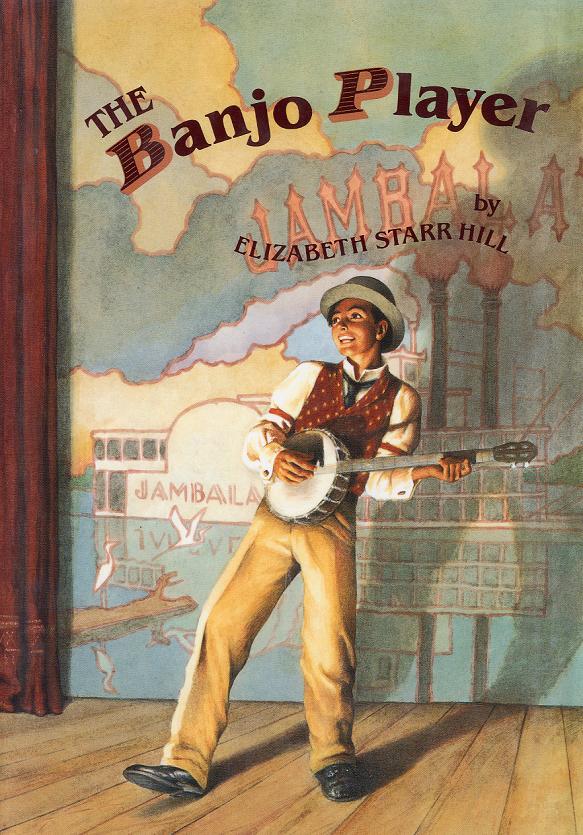
Nice cover for this juvenile fiction book. Jonathan Dale on the dust jacket looks uncannily like Michael Jackson. The Jonathan is performing on the stage of the showboat JAMBALAYA.
THE BANJO PLAYER by Elizabeth Starr Hill dust jacket art copyright 1993 by Dennis Nolan
Kirkus Reviews Issue: July 1st, 1993 In a prequel to Street Dancers and Broadway Chances, Hill goes back to Clement Dale's grandfather, Jonathan, on a journey from New York to New Orleans and beyond. At 12, Jonathan Dale leaves the city streets where he's gotten along on his own for years, performing for passers-by. In 1887, he boards the Orphan Train, hoping to be selected from the line of ragged homeless children for adoption. Chosen by a hardscrabble Louisiana tenant family, Jonathan struggles to fit in and to please his new parents but remains emotionally detached from them and new sister Eugenie (also from the Orphan Train). Jonathan needs people, music, and the chance to perform; the silent hours of grueling farm labor drain him. After exchanging situations with another orphan, he moves to New Orleans, then to a touring showboat, where he's encouraged to perform once again. Hill's prose is sure and vivid. Though Jonathan's aloofness is somewhat distancing, the story hums with well-drawn characters and quiet humor, ably bringing history to life. (Fiction. 10-14)
Pub Date: Aug. 1st, 1993
ISBN: 0-670-84967-7
Review Posted Online: May 20th, 2010
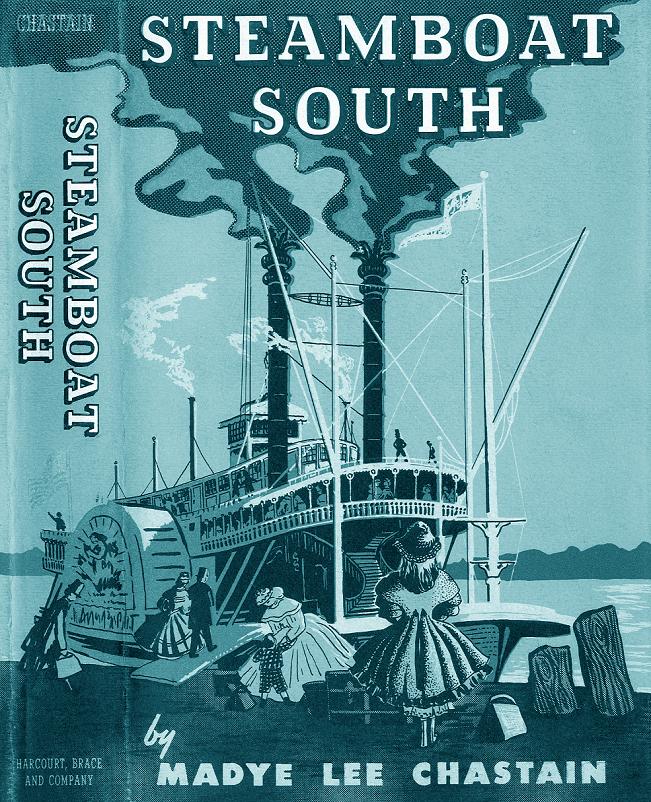
Finessed scan of a book cover painted by the authoress Madye Lee Chastain who also drew a sizable number of pen and ink illustrations inside the book as well. STEAMBOAT SOUTH
By Madye Lee Chastain
Pub Date: Aug. 23rd, 1951
Publisher: Harcourt, Brace
Kirkus' Review
Another dainty, starched story for little girls by the author of "Loblolly Farm" with a sizeable amount of period charm. Amy Travis could hardly believe that she was to go by steamboat all by herself from Ohio to Texas, but her only relatives, Aunt Agnes and Uncle Will, had saved enough money for her steamboat fare, and she was thrilled to be taking the wonderful journey and becoming a part of a real family. There were gay and exciting goings-on on the steamboat with the explosive Beazies, a family for whom Amy worked as part-time nursemaid, kind Mrs. Binkle, under whose protection Amy was allowed to see the dancing, and good times aboard ship, two lovely French girls, a kind itinerant painter and others. A story of kind friends and gentle people and ladylike excitement with a realistic glimpse of the days just preceding the Civil War.
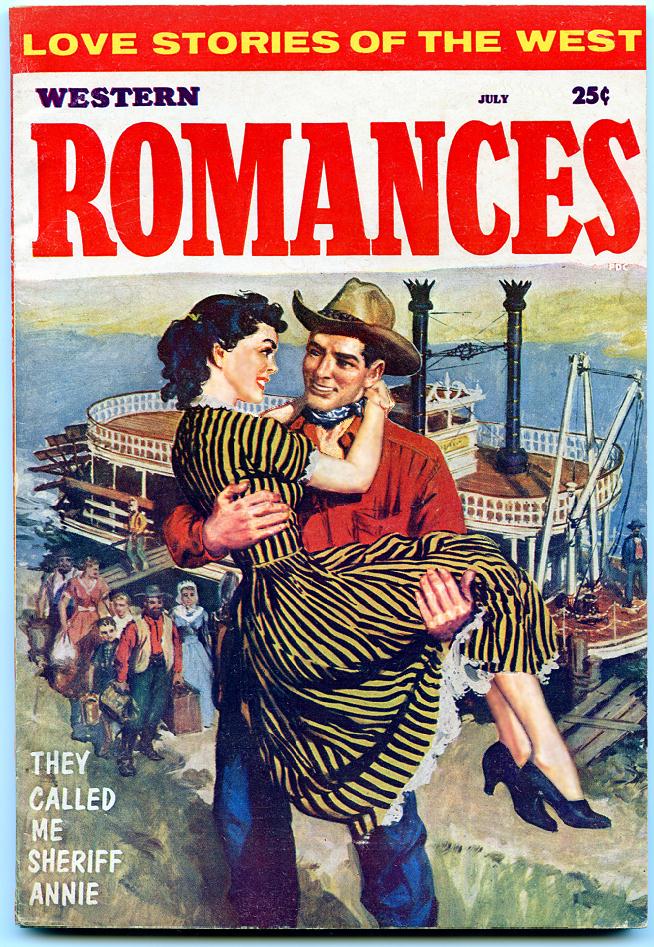
Some corny kitsch from 1958 . . . cover of the July issue of the pulp periodical WESTERN ROMANCES.
The cover painting of the brawny cowboy holding the "young filly" wearing modern "pumps" instead of the high button shoes which would have been worn in the Old West does not seem to illustrate any of the stories in this particular issue.
Immigrants who have just disembarked from the steamboat, perhaps somewhere along the Missouri River, must hope to establish homesteads on the frontier.
The cover served as part of the depiction of the nostalgic fantasy of Western life as a young girl of the 1950's girl would have imagined it to be, consistent with the genre of the short stories.
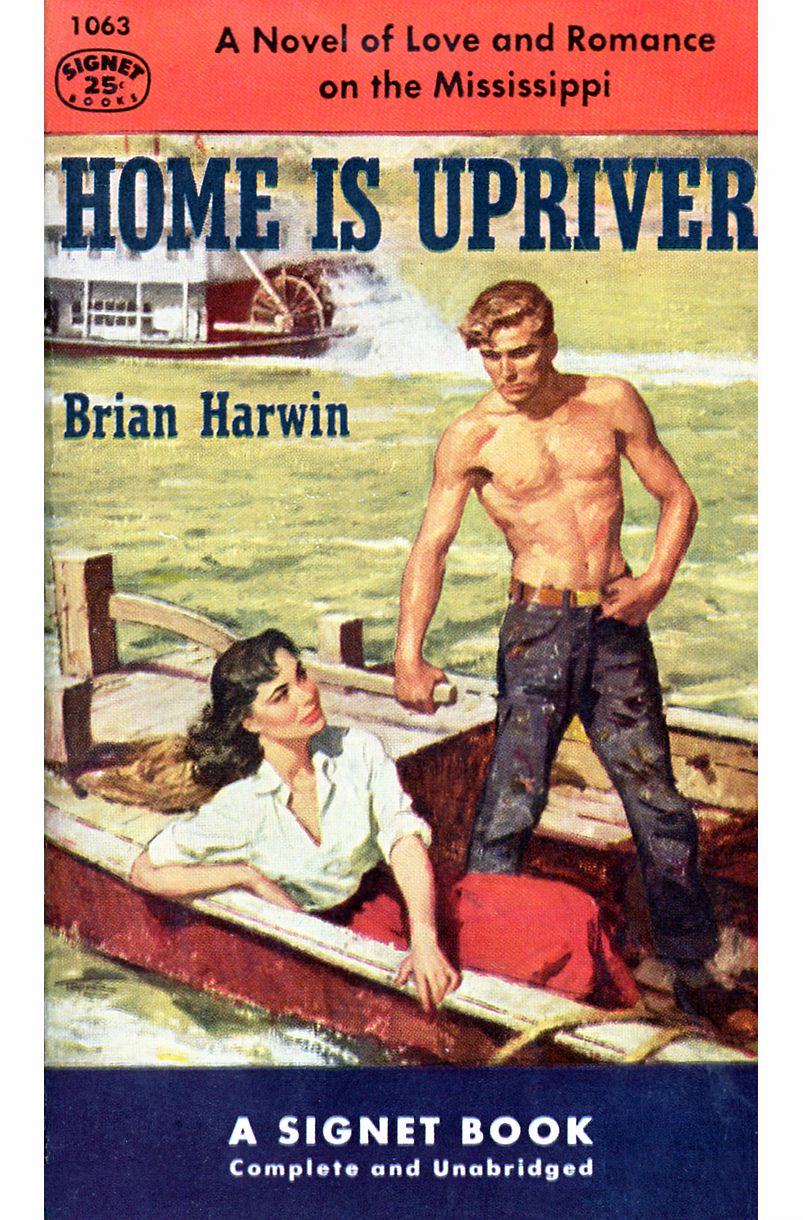
A cover illustration for Le Grand Henderson's 1953 novel HOME IS UPRIVER
Description by Dave Thomson:
Pulp novel cover with hunky hero Buck and his sultry wife Martha for Le Grand Henderson's 1953 novel HOME IS UPRIVER, which was published under the pen name Brian Harwin. In the novel Buck names his little Stover gas engine towboat Martha after his wife.
Biographical material gathered from Wikipedia:
Le Grand Henderson (1901 - 1964) was born in Connecticut and attended the Yale School of Fine Arts. After graduating from Yale he designed heating and ventilating equipment, switchboards for submarines, and window & interior displays for Macy's and Bloomingdale's in New York City. After moving to St. Paul, Minnesota Henderson began a year-long journey on a houseboat down the Mississippi River to the Gulf of Mexico.
He wrote and illustrated over a dozen children's books including these two books set on the Mississippi River:
Augustus and the River 1939
When the Mississippi Was Wild 1952
Home Is Up River, 1953 written by Le Grand Henderson and published under the pen name Brian Harwin by Signet Books
EXCERPTS - from pages 48 - 50:
When Buck decided to live on a houseboat on the Mississippi, he had been ingenious in persuading his bride to agree to it.
Martha's brother, Ramsey, heard about it, back home in Indiana, and he wrote a letter that began,
"The damn man's crazy."
Sister Jen added a postscript:
"All I say is, Martha, you're no lady if you go off amongst those riffraffs and river rats. I knew you shouldn't never have married that man. Always roaming from job to job."
Martha's widowed mother accepted it without comment. She lived with Jen, but she liked Buck.
The attitude of the other two was understandable: the Grants had been small farmers in middle-Indiana; then, when industrialism came, they had become steady, sober, and reliable holders of jobs in middle-Indiana.
Buck Sanjamon was a Louisiana Cajun. The name had been St. Germaine originally, and old Amedee St. Germaine had been among those forest-loving voyageurs from Canada who, with rollicking spirits and small canoes, tripped the Mississippi, singing lustily all the way to the Gulf.
The joy of motion was in Buck's blood, and he was a man who followed the joy where it led. Once it had led him to middle-Indiana, and that was how he had met Martha.
In the course of his wanderings, Buck had become an all-around good mechanic. The last of his many jobs ashore had taken him to the maintenance department of a machine shop in Baton Rouge, Louisiana.
And that was where he had the vision:
"I was working there, at the plant," he had told Kip, "and all of a sudden that old brick wall just faded away. And I could see, just as plain, the Mississippi River coming round a bend, all sparkly in the sun, like when I was on the river before. And I could see a shantyboat drifting on downriver. I could hear those little waves go wunk ga-lunk against the hull of that shantyboat. And I could smell that smell of wind and water and wet wood that ain't maybe as sound as boat wood ought to be."
Buck's blocky face was alight with the wonder of his vision.
"I was a riverman long before I got to be a land tarrapin, and I knew, right then, I had to go back to the river. I had some money saved up, and went down and bought the boat off old Nooky Rowe. . . .
. . . the boat Buck bought from Nooky Rowe was not a houseboat. She was an old and very small stern-wheel towboat about forty feet long. Most of the buckets were gone from her little paddlewheel, but she had a big old Stover engine in her cabin. It was rusty and needed overhauling, but it was a towboat's engine, and it could be fixed up.
And such an engine was more suited to river roving and river working than to lying tied to the bank . . .
from pages 54 and 55:
". . . nothing to hold us here now. The boat's all ready to go. We'll head out on the river, away from such damn' outfits as this." His voice was like a song. "You hear, Martha? We're going to travel the river."
Martha's eyes were glassy.
"I got it all planned out." Buck went on. "We'll tow timber rafts to the mills. There's good money in it. That old Stover engine will do it. It runs pretty good now, and I can fix it up later so's it'll purr like your sister Jen at feeding time." His eyes glowed. He patted Martha's shoulder with a touch that was an accolade.
"And you'll be engineer, Martha. Think of that. First damn' woman engineer on the whole Mississippi River."
"Buck," Martha said, "how much money do you have?"
. . . "Well, it all depends on how you look at it. We got the Martha. We got the little gas boat. We got, anyway, two weeks' groceries. We'll make a lot of money on the next rise of the river. Course, the river's low now, but when a rise comes there'll be a lot of drift timber floating down. Always is. It's those caving banks does it. Whole forests fall into the river. We'll catch that drift timber and make it up into rafts. We'll tow it to the mills. There's big money in that."
"Buck," Martha said. "How much money now?"
"Oh, you mean cash money. Well, right now we got more opportunities than cash money." He pulled a damp-looking wad of bills out of his pocket. "Forty-three dollars."
"Buck! How we going to get along on that?"
Buck looked pained. "Get along? We got the whole Mississippi River to get along on, ain't we? Look, Martha, I didn't go at this thing half-cocked. Just as soon as we get a little money out of that drift timber we'll go to buying up timber all along the river. Every old shantyboater's got a pile of drift tied up. We'll make it all up into rafts. We'll tow it to the mills. There's big money in it."
"But Buck, how we going to get along now?"
"Well, we'll catch the drift ourselves, first, like I said. We don't need money for that."
"But you said the river's low now," Martha reminded him. "You said there wouldn't be any drift timber until the river rises."
"Sure, that's right," Buck agreed amiably. "I guess we'll have to go to fishing for a while. Until a rise comes. They're getting good prices for fish these days."
Buck managed to get a few towing jobs, in addition to his fishing, by the time Storm was born. . . .
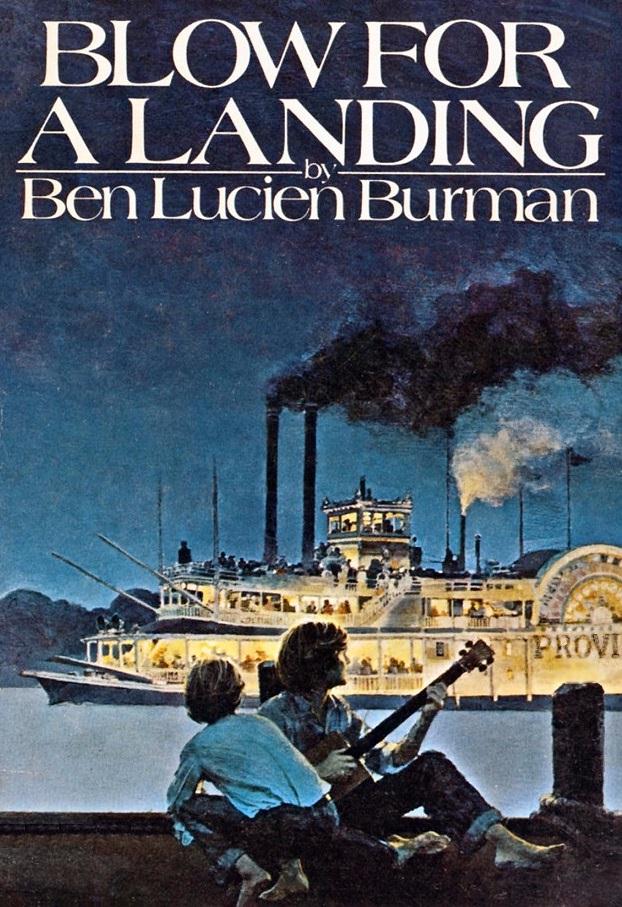
The cover of the 1974 paperback edition of Ben Lucien Burman's 1938 novel BLOW FOR A LANDING with a painted illustration by David Grove. Published by Ballantine as one of their "Mockingbird Books" (probably named in honor of Harper Lee's great 1960 "Southern Novel" TO KILL A MOCKINGBIRD).
In the Introduction to this edition Burman wrote among other things:
"I love to hear the melodious whistling of the steamboat, the rhythmic chugging of the excursion boat, the steamy thunder of the showboat calliope."
The first letters of the boat's name suggest it was named PROVIDENCE. The artist may have been inspired by photos of the sidewheeler CITY OF PROVIDENCE, built at the Howard Ship Yards in 1880 and ice on the frozen Mississippi near St. Louis caused her to sink in 1910.
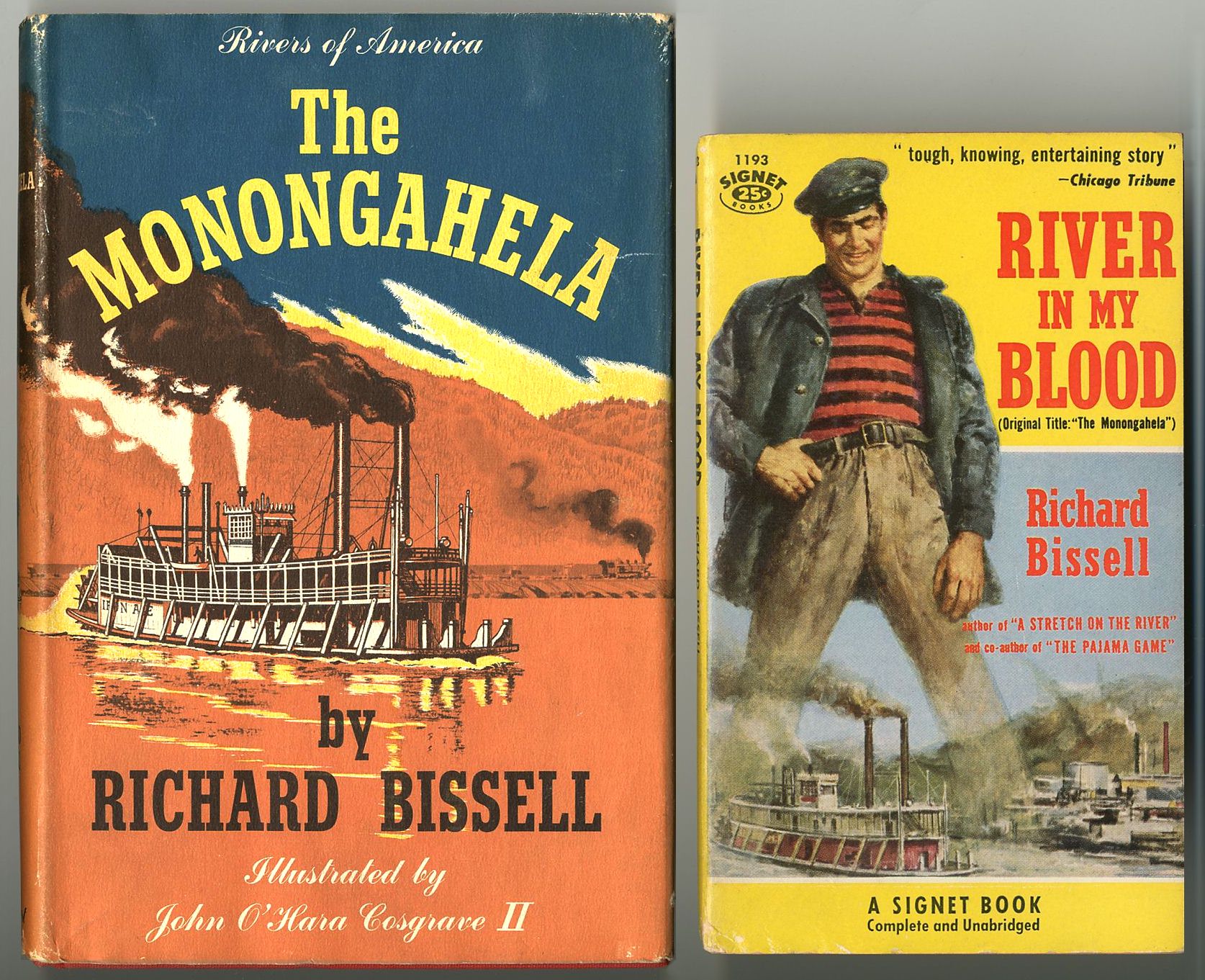
Richard Bissell's book THE MONONGAHELA (1952 Rinehart) had a "rebirth" 3 years later with a new name RIVER IN MY BLOOD (1955 Signet) and a men's "pulp novel" cover. Attached scans of both editions.
Below is the original review of the hardcover edition from Time Magazine.
Dave
Books: Workhorse River
Monday, Jun. 16, 1952
TIME MAGAZINE REVIEW
THE MONONGAHELA (239 pp.) - Richard Bissell-Rinehart ($3.50).
The series of books known as Rivers of America has given rise to some rather crude jokes in the publishing trade. When the number got to 45, wags began planning volumes on creeks, rills and even smaller flows. But, at least until No. 47 turns up, the kidding will have to stop. For No. 46 is one of the best in the series. It is also one of the few instances in which the right author met the right river.
Author Bissell, 38, helps run his father's clothing factory in Dubuque, Iowa these days, but once he did an outdoor man's work: he was a river pilot. He wrote a novel about it two years ago (A Stretch on the River - TIME, July 24, 1950), and the river descriptions and river lingo rang fair and true. He writes just as effectively in The Monongahela and even gives a fair amount of his secret away: "In order to have a river in your blood, unforgettably and forever . . . you have to work on her for wages." In 1944 he piloted a diesel towboat on the Monongahela for seven months.
Nuggets & Chasers. Bissell did some library work this time and, like his fellow grubbers in the River series, passes along his share of historical nuggets, e.g., in the 1790s, there were some 1,300 stills in western Pennsylvania; no less an authority than George Washington pronounced Monongahela rye "excellent,'' etc. But what gives the book its special tang is Pilot Bissell's own experiences on the old Mon. When he reported for duty on the Coal Queen, he saw a dirty one-stacker, "a piece of marine junk." That was winter time, and he had to be persuaded not to take the first train back to the Midwest. Came spring and Pilot Bissell thought: "For me to be drawing wages for piloting a towboat under these conditions. why, that's just like paying a kid to watch the circus."
Piloting the Coal Queen, from Morgantown, W. Va. downstream (north) to Pittsburgh, took a little doing, what with pushing barges through the locks and threading through more traffic tonnage than passes through the Panama or Suez Canals. There wasn't much that didn't catch Pilot Bissell's eye, from the architecture (mostly horrendous) of the houses ashore to a little girl in a spring hat on a slate pile. He remembers the valley's favorite drink (cheap rye and a beer chaser), the variety of foreign tongues heard in saloons. "Oh, it's some wonderful valley, the Monongahela. There's more hell popping and more loud noise in any ten miles at the lower end than there is in five hundred on the Mississippi or the Congo."
Good riverman that he is, Author Bissell writes with affection of the old steamboat days, when a big one like the Sprague could push as many as 60 barges loaded down with 54,000 tons of coal. He becomes nostalgic recalling that stern-wheelers in the '70s made regular trips on the highways of water between Pittsburgh and Fort Benton, Mont. But he knows that diesels are here to stay, and doesn't let his nostalgia get teary-eyed. Nor does he equate the ' Monongahela and the Coal Queen with romance. But when a stranger looked at the Queen and asked, "Ain't it a miracle what some fools will do to earn a living? Can you imagine living on a thing like that?", Bissell answered, "I can imagine it."
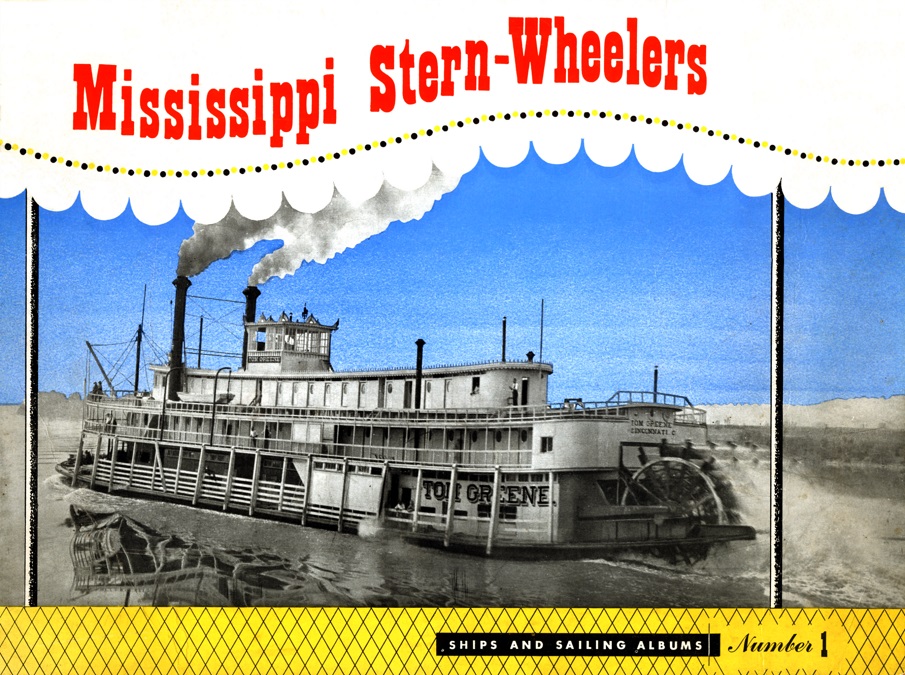
This is the cover of a 1947 spiral bound album compiled by Fred Way Jr. There were 5 albums in the Ships and Sailing series published by Kalmbach. The other 4 albums were devoted to sailing ships and passenger ships on the Great Lakes, ships of the U.S. Navy and New England Fishing Schooners
Fred's description of the photo on the cover:
The TOM GREENE operates as a combination general freight and automobile carrier between Cincinnati and Louisville. Daily service between these points has been maintained since 1831. This photograph was taken in 1923 when the packet was new and while she had her passenger cabin. In 1939 the staterooms were removed. This was next to the last packet built for operation on the Mississippi River system. She was named, appropriately, for Capt. Tom R. Greene, whose vision makes it possible today to take lengthy voyages along the inland waterways.
Photo by Capt. William S. Pollock.
THE SHIPS AND SAILING ALBUMS
BOOK 1
MISSISSIPPI STERN-WHEELERS
Compiled by Captain Frederick Way Jr.
10.25 x 14 inches
19 pages
36 photographs with comprehensive descriptions by Fred Way
Kalmbach Publishing Co.
Milwaukee, Wisconsin, 1947
INTRODUCTION:
For generations no Mississippi River steamboat was complete without a towering wooden superstructure surmounted with an elegant pilothouse, two stinking-hot smokestacks as alike as Gemini, a cursing Irish mate, a tuneful chime whistle, and a flashing paddle wheel at the stern wearing a beard of white foam. Vessels of this description were turned out by the thousands, ranging in size from the "short traders," with carrying capacities of but a ton or so, up to the mammoth cotton packets and coal-pusher towboats which accomplished Herculean feats unsurpassed in the history of transportation.
The stern-wheeler arrived as the ugly duckling of the rivers at the very beginnings of steam navigation on the Mississippi. The captains of the more swan-like side-wheelers scornfully dubbed them "wheelbarrow" boats. For 50 years they were in the minority. Those were the pre-railroad times when river boats were chiefly designed for speed and were hauling the passengers, the express, and the mail. Side-wheelers were the hot rods which chalked up all speed records accomplished on the Mississippi and its tributaries. Likewise, they exploded many boilers and roasted numerous humans in spectacular disasters. The stern-wheeler played second fiddle through those exciting times and did not arrive at importance until the character of inland river commerce took a shift.
Suddenly the scene changed. Inland United States was growing up, and Pittsburgh coal was in demand in New Orleans. Lumber from Minnesota and Wisconsin, grain from Illinois and Iowa, were needed southward. Railroads had sopped up the cream of passenger travel, the express, and the mail. The character of traffic on the rivers commenced to depend on economical transfer of heavy tonnage. Fortunately for rivermen, most of this traffic was headed down-river and could be floated to market assisted by the river's currents. In such manner the pioneer oil came down the Allegheny River from the wells of Pennsylvania, the coal from the mines of Pennsylvania, the timber from the forests of the St. Croix. The stern-wheeler was the ideal pushboat to handle such traffic, and its society was courted.
The stern-wheeler was the more economical type of vessel for Mississippi traffic from the start. Its lag may be attributed to early unwieldiness and its inability to maneuver with dexterity in the face of adverse winds and weather conditions. The arrival of steel boiler plate, and the consequent increase in steam pressures, gave the rear paddle wheel the "umph" it needed, and from then on it multiplied and eventually came near running the side-wheeler off the river. Stern-wheel river boats carried down the biggest rafts of timber, the greatest cargoes of coal, and the banner trips of cotton.
Again the scene changed. Nowadays the demands of river traffic accentuate vast movements of tonnage upstream against the currents. Texas sulphur is needed in Chicago, Louisiana oil is wanted in Pennsylvania and Minnesota, and, quixotical as it may seem, Kentucky coal is needed in the steel mills of Pittsburgh. The stern-wheeler was not designed for such service and fell far behind when such demands were made on it. In the past score years the diesel propeller-type workboat has been developed on the Mississippi and today outnumbers the stern-wheelers two to one. Significantly, no stern-wheeler has been built for river service in the past four years and, in the face of diesel competition, the older wooden ones are being sold at a dime a dozen.
This album is published at a fortunate moment. It captures the complete story of the stern-wheel river steamboat, a type of American vessel developed entirely within the United States with no borrowed ideas from abroad. These pages pay respect to Yankee ingenuity which overcame obstacles of a vast scale. The stern-wheel river boat never has been surpassed for shallow water downstream movement of tonnage, and its success is best attested by pointing out that designers and builders from Pittsburgh were called upon to duplicate such boats for the navigation of the Nile, Congo, Amazon, Yukon, Magdalena, Danube, and other waterways of the world. The stern-wheeler never failed its job. Like any highly specialized mechanical instrument, it served a special need, and now that the need has altered, its service is no longer required.
ABOUT FRED WAY JR.
This album is compiled by Capt. Frederick Way Jr. of Sewickley, Pa., who needs no introduction anywhere along the Mississippi River system where the water is deep enough to float a john-boat. He has captained and piloted practically every type of vessel which ever poked its nose into a mud bank or ran over a fresh-water catfish. For six years he managed a fleet of packets between Pittsburgh and Cincinnati on the Ohio River. Today he works occasionally as a "trip pilot" but has taken time off to write of many of his experiences, and his books on river life are acclaimed and read by the rivermen themselves—an honor of no mean order. One of his books, "The Log of the BETSY ANN," was a Literary Guild selection, and another, "Pilotin' Comes Natural," was reprinted in an overseas edition. The Captain was nearly swamped with overseas mail from boys homesick for their rivers.
Captain-Author Way is also a photographer, and for the past 25 years he has collected pictures of Mississippi steamboats and made copy negatives of his finds. At present he owns somewhere around 4000 negatives. The pictures in this album have been selected from this wealth of material.
Captain Way publishes an annual "Inland River Record" which lists the current vessels in operation, their dimensions, owners, power, type, and—to the glee of many rivermen—frequent personal comments. Between times he sails an 18-foot skiff, powered by an outboard motor, and in 1946 he toured the Ohio, Tennessee, Warrior, Tombigbee, Mobile and Licking rivers, upset in the Gulf of Mexico, and arrived at New Orleans upside down. The little boat is the "LADY GRACE," named for his wife, who, says the Skipper, weathers a storm as well as a professional.
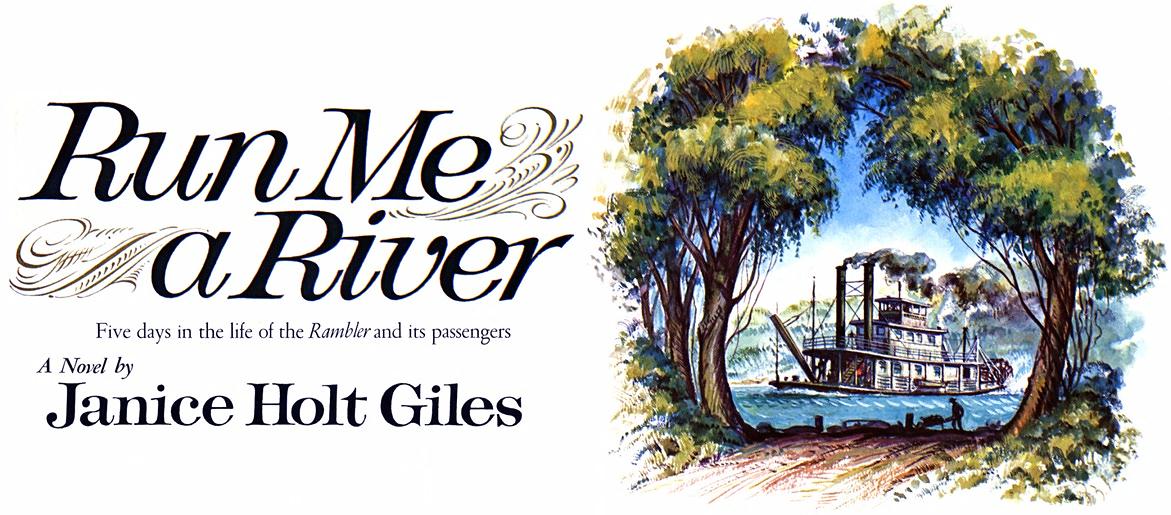
Attached comp of cover designed by Sam Bryant for RUN ME A RIVER which I have rearranged to fit in in a horizontal format
Run Me a River, Five days in the life of the RAMBLER and its passengers
by Janice Holt Giles
Houghton Mifflin Co. 1964
goodreads.com
The rich history of river life in Kentucky permeates Janice Holt Giles's novel "Run Me a River." Set in 1861, at the beginning of Kentucky's reluctant entry into the Civil War, the novel tells the story of a five-day adventure on the Green River. Aboard the "RAMBLER," a ramshackle steamboat, Captain Bohannon Cartwright and his crew journey 184 miles and pick up two extra passengers along the way. The boatmen rescue "Sir Henry" Cole, a former Shakespearean actor, and his granddaughter Phoebe from their skiff when it overruns in a squall. As romance blossoms between Phoebe and Captain Bo, a conflict escalates between Confederate and Union forces fighting for control of the river.
Janice Holt Giles (1905-1979), author of nineteen books, lived and wrote near Knifley, Kentucky, for thirty-four years.
Ms. Holt's acknowledgements excerpted from the last six paragraphs of the Foreword:
"I was helped by many people while doing research for this book. I cannot begin to list them all, but I am particularly grateful to the following:
Captain J. Frank Thomas, last master of the EVANSVILLE which burned at the wharf at Bowling Green on July 25, 1931, and for all practical purposes ended the river trade;
Mrs. Beulah Thomas, his wife, who gave me a woman's point of view of life on the river. I had three long interviews with Captain and Mrs. Thomas, whose patience extended beyond courtesy.
Captain Jim Wallace, retired towboat pilot and Mrs. Thomas' father, also granted me an interview. It was he, now past ninety, who "wrote the river" for me and whose river tongue gave me much of the language.
Through our good friend, Joe Covington, of Bowling Green, I met Warren Hines, a vice-president of the Hines Marine Towing Company, who interrupted a busy schedule to see me several times,
loaned me the company Scrapbooks (which were invaluable since the family has been in the river trade for four generations) and who finally did me the inestimable service of arranging a towboat trip downriver.
To no one else, however, am I more grateful than to Jim Nasbitt, owner of the towboat Maple, on which I made the downriver trip, and his son Buddy Nasbitt, pilot of the MAPLE.
They were gracious, hospitable and helpful. Without their help I could not possibly have learned as much as I did about the river and they gave it so cheerfully and willingly.
Miss Elizabeth Coombs, librarian of the Kentucky Building Library, Bowling Green, is an old friend and valued assistant in research. She is invariably interested, and wholly tireless in her efforts.
She found the old river map which is reproduced on the end papers in this book, as well as many old newspaper clippings, journals, histories and other useful documents.
JANICE HOLT GILES
Spout Springs, Kentucky
August 6, 1963"
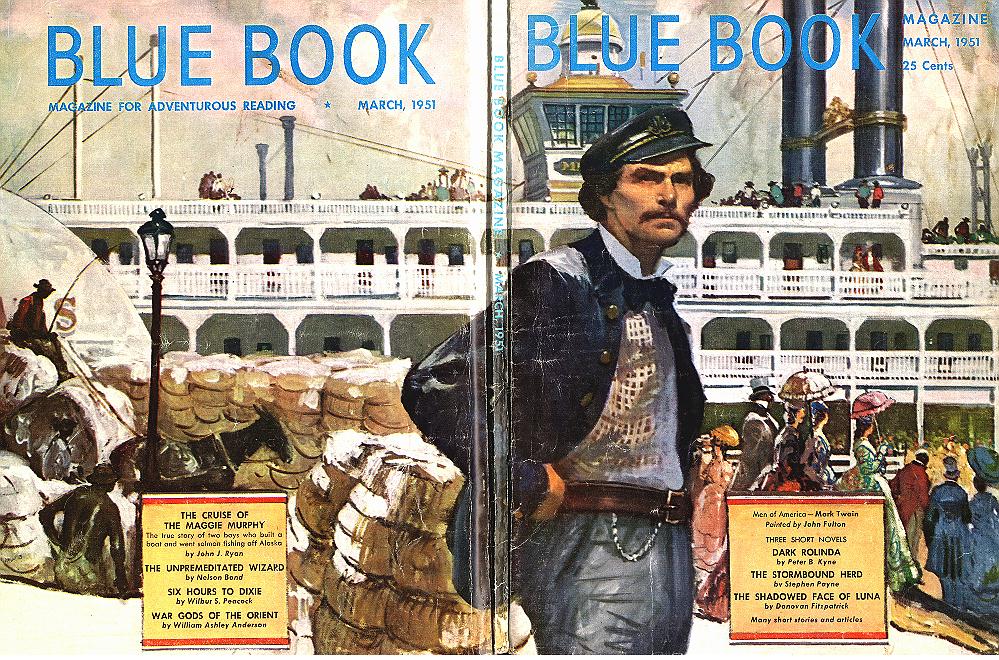
An illustrator named John Fulton did a series of "Men of America" portraits for the cover of Bluebook and this is concept of Sam Clemens the pilot although the model he used had a completely different bone structure in his facial features and Sam was sporting lamb chop whiskers at this time, not a mustache. The pilot house looks rather futuristic. I don't know of any from this period where the windows were angled up like that. Pilot houses on modern towboats are often built like this now, probably gives increased visibility and sheds rain better. The Great Republic (later renamed Grand Republic) and a few other big boats had cupulas like this on top of their pilot houses but they were an "over-the-top indulgence" to say the least.

With the exception of images credited to public institutions,
everything on this page is from a private collection.
Please contact Steamboats.com for permission for commercial use.*
All captions provided by Dave Thomson, Steamboats.com primary contributor and historian.
